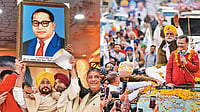It was while I was covering the Punjab assembly elections that a discussion with a young man of Jethuke village in Bathinda district, Harmandeep Singh, drew my attention to the new phenomena—a proliferation of small-time, independent Punjabi-language media outlets. I was already witness to how the Trolley Times had invigorated the farmers’ agitation in Delhi. Here I noticed how people were not only keeping an eye on mainstream TV and newspapers, but also monitoring the tech-driven new media—that, incidentally, also claimed to be an alternative media.
On that morning of on February 16, Harmandeep said: “The new Punjabi media emerged recently during the farmers’ movement. But with elections approaching, they have started copying mainstream channels. Instead of raising grassroots issues, their programming revolves around election rallies and candidate-interviews, like mainstream TV news.”
An elderly farmer standing next to Harmandeep chipped in: “These reporters were chasing just two-three questions: who is winning? Which party has a wave? Beyond this, they don’t explore anything else.”
Gurshamshir, a journalist with the Punjabi new media, affirmed what these two said: that as long as the farmers’ movement was active, Punjabi media was chasing issues. But as soon as elections arrived, they allegedly started getting manipulated by political parties. Suffering from a staff and funds crunch, their small workforce got sucked into covering anodyne press conferences of leaders and their mutual squabbling, forgetting the issues that agitated society.
It must be kept in mind that new media does not equate to alternative media by simply using new technology. On this topic, Shiv Inder Singh, the editor of news portal Suhi Saver, says: “Three kinds of new media outlets have emerged here in the past few years. The first are those which have investments from big capitalists, who, incidentally, also have a stake in mainstream media. The second are ones established by individual journalists, and are running by gathering resources through unconventional methods. The third are those that are funded by political stakeholders in Punjab. For example, political formations aligned with Sikhism have established several media organisations, which try to find a Sikh angle to every event.”
During the elections, all the new media outlets linked with Sikh politics focused on incidents of Beadbi (blasphemy against Sikh symbols and religion) and attacks against Sikhism. Actor-turned activist Deep Sidhu’s death in an accident on February 15, five days before the elections, continued to be the biggest news for them till the end of polling, because Sidhu was linked to Panth politics. An accidental death was turned into the main electoral highlight by these outlets.
With investments from big capital at the onset of poll season, the reporting style of these Punjabi new media outlets also started following mainstream TV reportage; preferring high-pitched drama and statements of the leaders over calm, reasoned analysis of actual issues, with interviews of candidates their prime focus.
The few small outlets established by individual reporters, on the other hand, still managed to stay on the real issues.
Yadwinder Karfew is among the journalists who opened their own digital channels, named Pro Punjab, a few days before the farmers’ movement began. Once an editor with a Punjabi TV news channel and a prime time news anchor, he left after his show was cancelled for doing a story that went against the ruling party, and his own employers put multiple restrictions on him. Karfew tells me while covering the elections: “Our channel has tasted success due to factual reporting of the farmers’ movement. However, we are facing several challenges during the elections. Advertisers want us to adopt the same tactics that mainstream channels use. So, we have been forced to imitate them in many ways. Thankfully, since the digital format does not have fixed time slots or number of stories, we have also been able to cover real issues. Digital channels have failed to establish a sustainable monetisation model, which has led to many kinds of limitations.”
All three types of new media has come under the scanner. Senior journalist Jaspal Sidhu says the quest for more ‘hits’ and ‘likes’ has led to every small item being presented as important. Clickbaits with provocative thumbnails aimed at gathering views has led to real questions getting submerged.
ALSO READ: Media And Manipur: Courage Under Fire
These elections also saw authorities being inundated with complaints of paid news. The DC of a Punjab district says: “District-level media certification and monitoring committees were formed to monitor paid news on newspapers, radio, TV, e-papers, bulk messages and social media, during the elections. The biggest problem our district committee faced was with news circulated on social media, which was often difficult to distinguish.”
What the official could not understand is explained by senior journalist Baljit Singh Balli in his own way: “This year, all political parties tried to ‘manage’ the Punjabi new media, and paid off large sums to outlets. The outlets described these as advertisements, which they were not as the political parties paid in cash, with no money trail. Nor have candidates registered these payoffs as electoral expenses. New media has also transformed the face of paid news, by providing most coverage to rallies, speeches and statements of candidates who paid them. As per my assessment, Aam Aadmi Party was the biggest offender.”
(This appeared in the print edition as "Tower of Babel")
ALSO READ
Mandeep Punia is an independent journalist

























